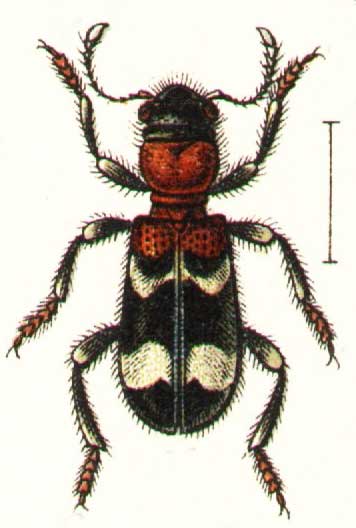
Thanasimus formicarius
Superregnum: Eukaryota
Regnum: Animalia
Subregnum: Eumetazoa
Cladus: Bilateria
Cladus: Nephrozoa
Cladus: Protostomia
Cladus: Ecdysozoa
Cladus: Panarthropoda
Phylum: Arthropoda
Subphylum: Hexapoda
Classis: Insecta
Cladus: Dicondylia
Subclassis: Pterygota
Cladus: Metapterygota
Infraclassis: Neoptera
Cladus: Eumetabola
Cladus: Endopterygota
Superordo: Coleopterida
Ordo: Coleoptera
Subordo: Polyphaga
Infraordo: Cucujiformia
Superfamilia: Cleroidea
Familia: Cleridae
Subfamilia: Clerinae
Genus: Thanasimus
Species: Thanasimus formicarius
Name
Thanasimus formicarius (Linnaeus, 1758)
Synonyms
Attelabus formicarius Linnaeus, 1758
References
Primary references
Linnaeus, C. 1758. Systema Naturae per regna tria naturæ, secundum classes, ordines, genera, species, cum characteribus, differentiis, synonymis, locis, Tomus I. Editio decima, reformata. Holmiæ: impensis direct. Laurentii Salvii. i–ii, 1–824 pp DOI: 10.5962/bhl.title.542: 387. Reference page.
Additional references
Zondag, R. 1979: Breeding of the clerid Thanasimus formicarius for the control of the bark beetles Hylastes ater and Hylurgus ligniperda in New Zealand. New Zealand journal of forestry science, 9: 125–132. ISSN: 0048-0134
Links
Thanasimus formicarius Taxon details on Fauna Europaea
Thanasimus formicarius (Linnaeus, 1758) - atlas of beetles of Russia (photo by D.I. Gavryushin)
ZooBank: DBAA1089-D3C6-4549-AA5A-A69866F0E3A0
Vernacular names
čeština: Pestrokrovečník mravenčí
Deutsch: Ameisenbuntkäfer
English: Ant beetle / European Red-bellied Clerid
suomi: Isomuurahaiskuoriainen, muurahaiskuoriainen
magyar: Vörösnyakú szúfarkas
lietuvių: Paprastasis keršvabalis
Nederlands: Bonte mierkever
norsk: Stor maurbille
polski: Przekrasek mróweczka
русский: Муравьежук
slovenčina: Pestroš mravcový
The ant beetle (Thanasimus formicarius), also known as the European red-bellied clerid, is a medium size insect, rather soft-bodied, with strong mandibles that can tear between the hard sclerotized integument of bark beetles. Larvae and adults are common predators of bark beetles in Europe.
Life cycle
The adults overwinter at the base of conifers, rarely of deciduous trees. They emerge in the spring and fly to lower parts of trees to hunt bark beetles. Their common prey are pine bark beetles Tomicus piniperda and T. minor, and the European spruce bark beetle, Ips typographus. Often they are seen waiting for their prey on the bark of fallen pine or spruce trees. Both ant beetles and bark beetles are attracted to monoterpenes from the damaged areas of the fallen trees. Stacked wood is especially attractive due to the monoterpene volatiles. The ant beetles are also attracted to specific pheromone components of bark beetles therefore they often fall into bark beetle pheromone traps.[1] The larvae enter the scolytid galleries and feed on the immature stages of the bark beetles. The larvae grow very slowly, spending two years in the larval stage, and pupate in the fall in niches in the outer bark. Adults of T. formicarius live 4 to 10 months.[2]
Males and females mate repeatedly, with many different partners throughout the season. Mating is short, and the copulation precedes a chase and a firm grasp of the female with the male mandibles on her pronotum.[2][3]
The females lay eggs from April to June. Usually they produce 20 to 30 eggs that they lay in bark crevices and in the vicinity of the bark of pine trees running tunnel of the bark beetle. The pink-colored larvae hatch after about a week and live under the bark, where they are predators of bark beetle larvae, eggs and pupae, but also feed on other insects living under the bark. In pursuit of their prey, they are also very quick and very skilled at moving the bark beetle corridors, where they can run backwards.
Before pupation, the larvae form an oval chamber which they line with mucus under the bark. The following spring the beetles emerge.[4]
Prey range
Thanasimus formicarius feeds on 27 bark-beetle species belonging to 15 genera (Dendroctonus, Dryocoetes, Hylastes, Hylesinus, Hylurgops, Hylurgus, Ips, Leperesinus, Orthotomicus, Pityogenes, Pityokteines, Polygraphus, Scolytus, Tomicus and Trypodendron) which infest coniferous (pine, spruce, larch, Douglas fir, and others), and broad-leaved trees (oak, ash, poplar, and others).[1][2][5]
Behaviour
The adults grab their prey with all their legs quickly so the prey can't run away. Then the beetle bites between the thorax and abdomen, or head and thorax to leverage out the soft succulent parts of a bark beetle. The whole feeding process takes only about 10 minutes. The clerids can feed on about 3 bark beetles per day for several days. It is interesting that once a clerid begins to feed it almost always finishes the process so it never wastes prey.[3][6] Different experiments suggest that ant beetles prefer Pinus trees over Abies or Picea for oviposition. Some experiments suggested that bark thickness could be a critical factor limiting pupation of T. formicarius on spruce.[7] Possible mimicry: The shape of the body and coloration of ant beetles resemble those of velvet ants from the genera Mutilla that can be seen on the same places with ant beetles. Velvet ants are famous for their painful stinging.
References
N.J. Mills, "The natural enemies of scolytids infesting conifer bark in Europe in relation to the biological control of Dendroctonus spp. in Canada", Biocontrol News and Information, Vol. 4, Issue 4, pp. 305-328, 1983.
R. Gauss, “Der Ameisenbuntkäfer Thanasimus formicarius Latr.als Borkenkäferfeind,” pp. 417-429 in G. Wellenstein (ed.), Die grosse Borkenkäferkalamität in Südwest-Deutschland 1944-1951, 1954.
John A. Byers. "Thanasimus formicarius".
Bohumil Starý, Pavel Bezdecka, Miroslav Capek, Petr Starý, Georg Benz, et al.: Atlas der nützlichen Forstinsekten. Ferdinand Enke, Stuttgart 1990, ISBN 3-432-97121-4, S. 37 u. 76
B.A. Tommeras, “The clerid beetle Thanasimus formicarius is attracted to the pheromone of the ambrosia beetle Trypodendron lineatum,” Experientia, Vol. 44, pp. 536-537, 1988.
"Archived copy". Archived from the original on 2012-08-05. Retrieved 2012-02-07.
Why a Large Range of Prey for a Specialized Predator? Nathalie WARZEE, Jean-Claude GREGOIRE Biological Control and Spatial Ecology, Lab CP 160/12, Free University of Brussels, 50 avenue F.D. Roosevelt, B-1050
Retrieved from "http://en.wikipedia.org/"
All text is available under the terms of the GNU Free Documentation License

